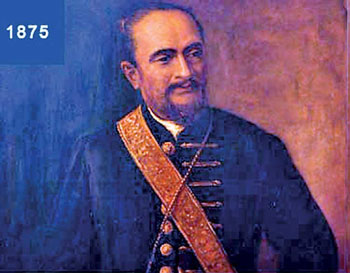Remembering a great philanthropist
In or around 1071 A.D., six Brahmins from Kerala, India, were escorted to Sri Lanka on the orders of King Vijayabahu 1 who reigned from 1055-1110. The king wished to have a coronation befitting his achievement of uniting the whole island under one monarch after 17 years of war against invading Cholas from South India. The Indians who landed near present-day Beruwala were Paisa Brahmins well versed in the procedures for conducting coronations befitting ‘Great Kings’.
There is a plethora of evidence for this historical arrival although different versions of names, dates etc. can be found in books and scholarly publications written on the subject. Most elaborate on the facts based on the caste of the writer either embellishing or degrading the background information and the influence the immigrants had on the island!
The influential trader and chief of the merchant navy that serviced the Kings of Lanka at the time, Periya Mudali Marikkar of Beruwala was in charge of arranging the passage of these Brahmin priests from Saliyapatnam, possibly present-day Kochi in Kerala.

Since there were no qualified priests in Lanka who could conduct the coronation in true Indian fashion, the King rewarded Periya Marrikar handsomely. Details of the rewards were inscribed in a gold leaf (sannasa) and given to Periya Marrikar as was the tradition at the time. This gold leaf was reportedly taken to Britain by the colonialists and its current location remains a mystery.
Soon after arrival, the six Brahmins were brought to the land on the backs of the locals (presumably to preserve the ‘Brahmin purity’), given authority to ride elephants and horses, and provided with all other necessities including virgins as consorts. All these details can be found on their family flag. This magnificent pictorial presentation begins at the bottom left corner of the flag and proceeds to the right and weaves sequentially in a zig-zag fashion.
The original settlement of the new arrivals was in today’s Balapitiya (then Welithota). The area is known as Brahmana Watta (Estate of the Brahmins) even today.
The Brahmins were bestowed with fitting last names by the King and eventually settled along the coastal region from Puttalam to Hambantota. One of them who received the last name Rajapakse (there are different versions of the spelling in various sources) decided to stay in Welitota. His descendants, later referred to as Kappina Clan, eventually became very influential in shaping the country until mid-twentieth century.
The well-known, now demolished Maha Kappina Walawwa, which was the main backdrop of many Sinhala movies including ‘Gamperaliya’ became the epicentre of the Kappina clan. Gate Mudaliyar Samson Rajapakse was a direct descendant of this Kappina clan.
A portrait of Mudaliyar Samson Rajapakse in full official attire was printed in a book written in 1887 by the British author John Ferguson who records with great admiration the philanthropic endeavors of the Mudaliyar and notes his benevolence as an example for all other wealthy natives to follow.
Samson Rajapakse, born on December 30, 1830, was the only son of Maha Mudaliyar Adrian Rajapakse who was one of the richest and most philanthropic aristocats of the day. The name ‘Samson’ was given to his son in memory of a senior British military officer who was a close associate of Adrian Rajapakse.
Young Samson was educated at Royal College in Colombo 7, then known as the Colombo Academy, where he excelled in English and Latin Language studies. Later, he returned to Balapitiya (Welithota) and studied Buddhism under several prominent monks.
The implementation of the Colebrooke-Cameron reforms between 1832-1835 brought about significant changes in the plantation activities in the island. All government owned cinnamon and coconut plantations were sold and a large portion including the whole of ‘Cinnamon Gardens’ in Colombo was bought by Maha Mudaliyar Adrian de Silva Rajapakse in 1824. At the time he was the most senior officer among the locals who served the British colonialists.
His son Samson, then the Mudaliyar of Governor’s Gate, managed these cinnamon and coconut plantations. Subsequently, his son Tudor Rajapakse, born at Welitota in 1868, managed the plantations and improved them by acquiring other lands around these plantations.
During the first decade of the 20th century, the family had extensive coconut and cinnamon plantations, that some estimates at over 50,000 acres extending from Puttalam to Hambantota along the coast and extending to upcountry. The coconut plantations in and around Negombo alone encompassed the present Katunayake International Airport, adjacent Sri Lanka Air Force lands and the Negombo tourist hotel zone.
Samson Rajapakse and his only son Tudor Nathaniel Rajapakse made several notable contributions to society. The first permanent building of Ananda College was ceremonially declared opened by Gate Mudaliyar Tudor Rajapakse on August 23, 1895.
Samson funded and arranged the construction of the Galle Clock Tower (1883) in memory of his personal physician Dr. Peter Daniel Anthonisz who had passed away prematurely. The clock unfortunately doesn’t function anymore and the plaque denoting his contribution has eroded beyond recognition.
Maha Mudaliyar Samson Rajapakse passed away on January 26, 1888 at the age of 57 years after a brief illness. His 135th death anniversary was marked this year. His son Tudor was then elected Maha Mudaliyar and proceeded to complete the many projects his father had started.
Despite the significant contributions by Samson Rajapakse, there is not even a road named after him in Colombo 7 (Cinnamon Gardens) which he wholly owned at one time. - Nimal Rajapakse
Leave Comments